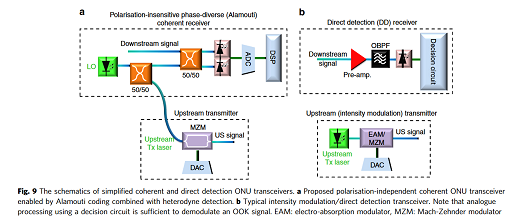UK researchers have tested a novel design for an optical transceiver that could provide dedicated data rates to each user of more than 10Gb/s for a truly super-fast, yet low-cost, broadband connection to every UK home.
The demonstration, reported in Nature Communications last month, builds on work by scientists from the UCL Optical Networks Group and the University of Cambridge to develop a new, simplified coherent receiver for use in optical access networks. The research was funded by the UK’s Engineering and Physical Sciences Research Council (EPSRC) through its Unloc Programme, and Huawei Technologies.
Coherent communication systems offer improved power and bandwidth efficiency, which translates into faster speeds and longer reach. They are widely used in long-haul optical transmission but are considered too expensive for deployment in optical access networks.
The new, simplified receiver retains many of the advantages of coherent receivers, but is simpler, cheaper, and smaller, requiring just a quarter of the detectors used in conventional receivers, according to lead researcher Dr Sezer Erkilinç from UCL’s department of Electronic and Electrical Engineering.
The design borrows a technique from the wireless world, Alamouti coding. Originally designed to prevent signal fading in wireless communications, the information is distributed over two states of polarisation. The original signal is sent in the first time-slot, while its reciprocal pair or ‘complex conjugate’ is included in the adjacent time-slot.
The coding scheme introduces 50 per redundancy into the system – effectively halving the available bandwidth – because both polarisations are used to send one signal. But it allows the receiver to detect just a single polarisation, which reduces the number of components required.
“The complexity is shifted from the ONU [optical networking unit in the customer’s home] to the ONT [optical networking terminal at the central office],” Erkilinç explained. “There is a trade-off, but it is very attractive for the access network because the cost of the ONT is shared between all the users but the cost of the ONU has to be borne by the end user alone.”
Although the receiver design had been demonstrated previously, this was the first time that the researchers had built a complete coherent transceiver. Crucially, in this implementation the laser in ONU – in the customer equipment – was used simultaneously as a local oscillator laser for the downstream receiver and a transmitter laser to send the upstream signal. This is a significant advance, since it removes the requirement for an extra laser in the ONU.
Figure credit: M. S. Erkılınç et al., Nature Communications (CC BY 4.0)
The complexity of the resulting ONU optical transceiver is comparable to today’s direct-detect schemes, requiring just one laser and one balanced detector – in addition to some simple passive couplers. But it’s performance should be significantly better, the researchers claim.
“This simple receiver offers users a dedicated wavelength, so user speeds stay constant no matter how many users are online at once. It can co-exist with the current network infrastructure, potentially quadrupling the number of users that can be supported and doubling the network’s transmission distance/coverage,” stated Dr Erkilinç.
The system has been demonstrated over an installed fibre network between Telehouse (East London), UCL (Central London) and Powergate (West London) – part of The National Dark Fibre Infrastructure Service (NDFIS). The team successfully sent data over 37.6km and 108km to eight users who could download and upload data at a speed of at least 10Gb/s. This is more than 30 times faster than the fastest broadband available in the UK today.
The receiver has been tested at a higher speed using higher-order modulation format with bidirectional operation – 21.4Gb/s downlink and 10.7Gb/s uplink signals propagating simultaneously in the same fibre. “This is extremely important, as most of the today's passive optical networks are also bidirectional,” Erkilinç pointed out.
Although not a full field trial, it tested the transceiver under real-world conditions – with the associated realistic fibre parameters such as loss, dispersion, polarization mode dispersion, and polarisation rotation – not just over spools of fibre in the lab.
Future work will focus on improving the design. The researchers plan to reduce the electrical power requirements of this technique to make it commercially viable in the nearest future. “We believe that it has real potential to provide high-speed broadband connectivity to every home, which will support the growing digitally enabled economy in the years to come,” commented co-author and head of UCL’s Optical Networks Group, Professor Polina Bayvel.
Journal Reference:
M. S. Erkılınç, D. Lavery, K. Shi, B. C. Thomsen, R. I. Killey, S. J. Savory, P. Bayvel. Bidirectional wavelength-division multiplexing transmission over installed fibre using a simplified optical coherent access transceiver. Nature Communications, 2017; 8 (1) DOI: 10.1038/s41467-017-00875-z



